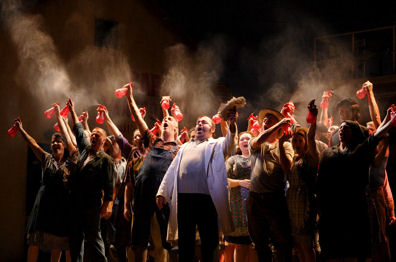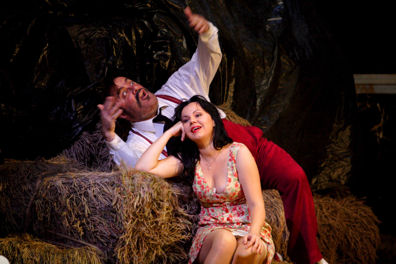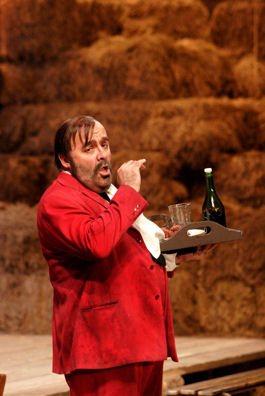Other Links
<Editorial Board
- Editor - Bill Kenny
- London Editor-Melanie Eskenazi
- Founder - Len Mullenger
Google Site Search
SEEN
AND HEARD OPERA REVIEW
Donizetti, L’elisir d’amore:
New production, soloists, orchestra and chorus of The Royal Opera,
Laurent Pelly (director and costume designs), Chantal Thomas (set
designs), Joël Adam (lighting), Mikko Franck (conductor), Covent
Garden, London 13.11.2007 (JPr)
Although this co-production is new to Royal Opera, it has already
appeared three times at the Opéra National de Paris where it
premièred in June 2006. It is by the same team- Laurent Pelly,
director and costume designer, set designs by Chantal Thomas and
lighting by Joël Adam - that had such a great success recently
with La Fille du régiment at Covent Garden.
All of this should have worked much better than it did. What
L’elisir needs is laughter and tears otherwise what's the
point? I counted only four potentially big laughs when the
audience chuckled together rather than individually. The short
catalogue consisted of Dulcamara’s ‘Udite, o rustici’, the end of
the scene when a fast-moving Jack Russell terrier runs back and
forth across the stage and then back, when Adina is showered with
confetti to her evident dislike and finally when the quack doctor
sings how his cure is not only for the love struck but it makes
the penniless rich. We should be made also to care about Adina and
Nemorino equally but for me she was too shrewish and he was too
much of a dolt. There was little evidence that Adina had more
feeling for Nemorino than any of the village girls capriciously
attracted by the fortune he inherits when his uncle dies.

Donizetti’s melodramma giocosa has been
popular since its première in Milan on 12 May 1832: the
description alludes to its being a story with some humour rather
than a comic opera. This is, if anything, a play extracting its
laughs from the social mores of a small Italian village where
Spring has sprung and love is in the air. Adina owns the local
farm, her friend Giannetta and a group of peasants are resting and
at a distance Nemorino, a young villager, sadly laments he has
nothing to offer Adina but love. The farm-workers urge Adina to
read the story of Tristan who won the heart of Isolde by drinking a
magic love potion. Nemorino decides to take another magic
elixir sold to him by a quack, Doctor Dulcamara, so that he can
win Adina’s heart - but to spite him, Adina has already
announced
her marriage to a swaggering army sergeant. The elixir turns out
to be nothing but red wine and - as in most rom-coms - despite
trials, tribulations and misunderstandings true love wins through
in the end. Donizetti’s music is potentially full of charm and the
amusing story is timeless.

The prostitute was always an important figure in Italian post-war
cinema and this genre, typified by Fellini, is very much the
world that Laurent Pelly wants to evoke. Adina comes across very
unsympathetically and is first seen sunning herself on a ziggurat
of hay bales as the curtain rises. There is a distinctly French
take on Italian peasant life in the production however, and when
the braggart sergeant swaggered in with his 'little and large'
soldier companions I thought was at ‘Allo ‘Allo-the musical'
watching Captain Bertorelli rather than Belcore.
No-one seeing this production can complain about cut-out sets this
time (unlike across town at the Coliseum) because no expense has
been spared, and apart from one far distant visual joke showing
the departing Dulcamara, almost everything was solidly
three-dimensional; there is a hay-baler, a tractor, a roadside
trattoria, scooters and bicycles and the lorry-load of Dulcamara’s
elixir. The passing of time is realised by the lighting and a
background that changes from sun-drenched to starry sky as the day
progresses. The big scene change in Act I is accompanied by a
front cloth with adverts entertainingly explaining how Doctor
Dulcamara’s potion is a cure-all for everything …and I mean
everything … accompanied by suitable pastoral sounds, including
crickets.

I enjoyed the evening, but once again think the raison d’être
for performing this work is to have big broad performances
that make the pathos and comedy live. None of this present cast
was up to it in a way their Covent Garden predecessors have been.
All are certainly superb physical actors, but there is no way I
could imagine previous Nemorinos I have seen - such as Nicolai
Gedda or Pavarotti (to whom this run of performances has been
dedicated) - clambering up and down hay bales. However, the
ability to make a character real on its own is the province of
straight theatre and in opera the artists need to keep attention
focussed by their singing. Here the singing was rather
one-dimensional - unlike the sets.
Polish soprano, Aleksandra Kurzak (Adina) and Stefano Secco
(replacing the originally cast Rolando Villazón as Nemorino) have
perfectly fine small, young voices. Probably because of his
relative inexperience Stefano Secco's ‘Quanto è bella’ came before
he had really warmed up and Ms Kurzak seemed to be tiring the
time she sang ‘Prendi, per se sei libero’ to confess her love
for Nemorino, which should be the zenith of her part. His ‘Una
furtiva lagrima’ must always be a show-stopper: here it was
pleasant enough but no one was likely to demand an encore as with
tenors of old.
I cannot imagine that anyone in the upper reaches of the opera
house heard everything that these two sang but there were some
very good directorial touches. At moments of exclamation it was a
neat idea to have the villagers turn away from Adina and cover
their ears and often throughout the work, characters turned
toward the audience to draw us into the plotting. This too was a
good idea.
A certain blandness also extended to Dulcamara and Belcore. The
Italian, Paolo Galvanelli, is a Verdi baritone and not a buffo
and there was a certain lack of comic timing and emphasis in his
performance although his voice was certainly as potent as the
villagers believed his elixir to be. Ludovic Tézier from France
had an equally fine voice but sounded like Escamillo in his
vaingloriousness when there should be more of an element of
preening self-importance to Belcore. In the United Nations cast
the Jette Parker Young Sri Lankan soprano, Kishani Jayasinghe, was
a pert Giannetta.
I don’t think the animated chorus or orchestra could be faulted in
any way but I longed for just a little more sunshine in the
Finnish conductor Mikko Franck’s account of the score: this well
may happen as the run continues and indeed the principal singers
may even relax more into their roles.
While I never wanted L’elisir to be reinvented against
perhaps a backdrop of farmers’ worrying about EU subsidies
or the effects of Bird flu or Bluetongue, for me this was a rather
‘small house’ L’elisir , something that might be put on at
the Vienna Volkoper or in a successful West End. It was a
thoroughly pleasant and inoffensive evening at the opera and
perhaps there is no more to be expected when Royal Opera is let
down by the star tenor around whom this production was planned.
Recently writing about Aida, I applauded the return of big voices and ‘Grand Opera’ and accepted that great acting would not be expected. Here we had committed and well directed acting with voices of potential but probably most were singing either the wrong roles or singing them too early in their careers. It seems the ideal would be something between the two extremes of course, but it’s the quest to find that, which is what brings me back to opera, time and again.
Jim Pritchard
Pictures © Catherine
Ashmore
